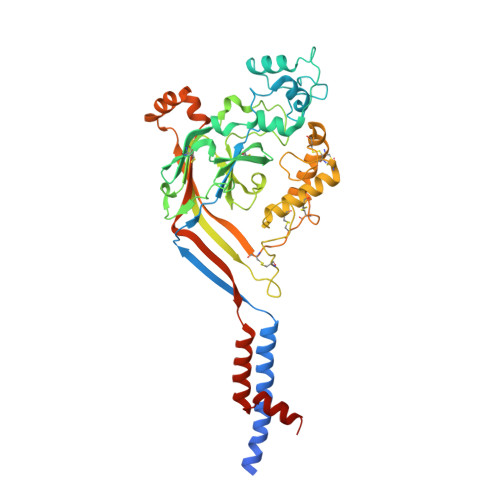Divalent cation and chloride ion sites of chicken acid sensing ion channel 1a elucidated by x-ray crystallography.
Yoder, N., Gouaux, E.(2018) PLoS One 13: e0202134-e0202134
- PubMed: 30157194
- DOI: https://doi.org/10.1371/journal.pone.0202134
- Primary Citation of Related Structures:
6CMC - PubMed Abstract:
Acid sensing ion channels (ASICs) are proton-gated ion channels that are members of the degenerin/epithelial sodium channel superfamily and are expressed throughout central and peripheral nervous systems. ASICs have been implicated in multiple physiological processes and are subject to numerous forms of endogenous and exogenous regulation that include modulation by Ca2+ and Cl- ions. However, the mapping of ion binding sites as well as a structure-based understanding of the mechanisms underlying ionic modulation of ASICs have remained elusive. Here we present ion binding sites of chicken ASIC1a in resting and desensitized states at high and low pH, respectively, determined by anomalous diffraction x-ray crystallography. The acidic pocket serves as a nexus for divalent cation binding at both low and high pH, while we observe divalent cation binding within the central vestibule on the resting channel at high pH only. Moreover, neutralization of residues positioned to coordinate divalent cations via individual and combined Glu to Gln substitutions reduced, but did not extinguish, modulation of proton-dependent gating by Ca2+. Additionally, we demonstrate that anion binding at the canonical thumb domain site is state-dependent and present a previously undetected anion site at the mouth of the extracellular fenestrations on the resting channel. Our results map anion and cation sites on ASICs across multiple functional states, informing possible mechanisms of modulation and providing a blueprint for the design of therapeutics targeting ASICs.
Organizational Affiliation:
Vollum Institute, Oregon Health & Science University, Portland, Oregon, United States of America.















